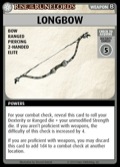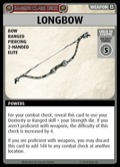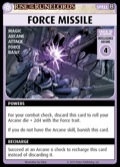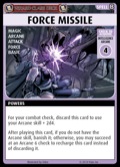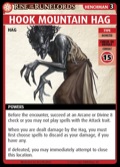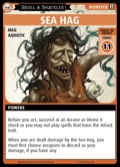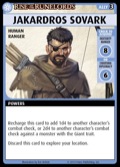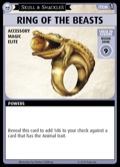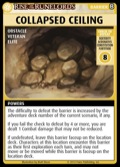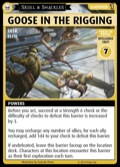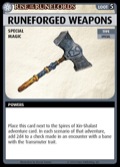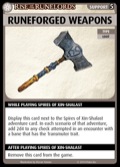Apologies in advance, as this blog entry is going to get a bit arcane. No, I don't mean it's not rechargeable by a Divine spellcaster—I mean this article is meant for Pathfinder Adventure Card Game rules enthusiasts. I'm going to define the differences between the PACG rules a year ago and the ones we have now, possibly in excruciating detail. You've been warned.
When we set out to design the new Skull & Shackles sets and the Class Decks, we had heard many players pointing out ways our game could improve. We were faced with a fork in the road. Choosing Path One meant leaving everything alone and forging ahead with what we had created as is. That was the path of least resistance, requiring very little explanation, but keeping in place some things that were confusing about our game. Choosing Path Two required us to change those things and explain them in a blog like this one. I think you folks are good enough pathfinders that you know which one we picked.
So, yeah, some things are going to look a little different from now on. These are not the kinds of things we're going to issue errata for; everything works pretty much the same as it did in Rise of the Runelords. But the new cards will look just a bit different. Here are some of the highlights.
To start out, let's look at two versions of the weapon Longbow: the first one is from Rise of the Runelords, and the second is from the Ranger Class Deck.
There are some minor differences here. The first is the replacement of the phrase "roll your Dexterity or Ranged die" with "use your Dexterity or Ranged skill." In Skull & Shackles, "skill" always refers to your base die (say, a d8) plus any skill feats or bonuses you might have. If Harsk is using the Longbow with Ranged: Dexterity d8+2, and he has two +1 skill feats in Dexterity, his Ranged skill is d8+4. The concept of the "unmodified" die is also gone: when we say "die" now, we always mean just the die. So if Harsk is using the Longbow, and he has Strength: d6 and one +1 skill feat in Strength, adding the Strength die to his Ranged skill means he adds the d6 and ignores the feat, just as before. The wording is more specific, but the math hasn't changed at all.
A subtler change on the card is replacing the word "a" with "any" in the last power. This makes it a bit more clear that it applies to checks other than your own.
Okay, now for a couple of spells. Here's the Runelords version of Force Missile and the new one from the Wizard Class Deck.
There are two big changes here. Most visibly, the recharge box is gone. Players seemed to get confused by the recharge box, including figuring out when to apply that power, so we built the recharge power into the powers box. With luck, people won't be baffled by that any more.
Reading the text, you'll note that the power no longer tells you to apply the Force trait. That's because this rule is clearly stated in the rulebook:
Some cards may allow you to replace the required skill for a check with a different one. As part of this action, you may play only 1 card or use only 1 power that defines the skill you are going to use. When you play a card that does this, add that card's traits to the check.
So Force Missile still adds the Force trait to your combat check (along with the Magic, Arcane, Attack, and Basic traits)—it just doesn't spell it out in a way that suggests it's somehow different from those other traits.
Now let's compare two scary ladies: the Hook Mountain Hag from "The Hook Mountain Massacre" and the Sea Hag from the Skull & Shackles Base Set.
In Runelords, things that happened "before the encounter" really happened during the encounter, after you had a chance to evade the card. In Skull & Shackles, there’s a new step called "acting," which includes everything that happens after you choose not to evade a card up until the encounter is resolved. Things can happen before you act, while you act, and after you act. Here’s the rulebook text on the "before you act" step.
Apply Any Effects That Happen Before You Act. If any powers on the card you're encountering happen before you act, they take effect at this time. You may also use powers or cards that state they can be used before you act.
Another change here is replacing the phrase "spells with the Attack trait" with "spells that have the Attack trait." The meaning of "with" was not clear enough: did it mean you couldn't play a spell that itself had the Attack trait, or did it mean you couldn't play a spell in conjunction with any card that gave the Attack trait to the check? The new wording makes it clear that the intent is the former.
A side note on henchman cards: The rule about henchmen automatically allowing you to close a location after you defeat one is gone from the rulebook. If a henchman allows you to close the location when it's defeated, it says so in its power; if not, it doesn't. (I expect you won't like the ones that don't. They're called Curses, and we'll leave them for another day.)
Here are two boons: the ally Jakardros Sovark from "The Hook Mountain Massacre" and the item Ring of the Beasts from "The Wormwood Mutiny".
In Runelords, you'd occasionally see a card that helped a combat check "against" a monster. That term "against" was never defined, but it benefited from some definition, because it could also apply to checks of other sorts. Now, the new phrase "check against a card" applies to any check the card mandates. The rule is:
If a card refers to a check against another card, that refers to any check required by that card, whether it's a check to defeat, a check to acquire, a check to recharge, or any other check.
Here's the Collapsed Ceiling, a card I kinda wish we didn't put in Runelords, because it needed rules support that the game did not provide. That's been solved, so you'll see a lot of cards like Goose in the Rigging from "The Wormwood Mutiny".
It was frustrating not to be able to answer all the questions associated with Collapsed Ceiling. For example, it wasn't clear what happened when you had two faceup cards on the deck or when something suggested you shuffle one of them into the deck. The Skull & Shackles rules now tell you how to handle cards like this.
Faceup Cards: Sometimes a card is left faceup on the top of the location deck (for example, most barriers with the Task trait work this way). The card is still in the deck, but it can only be shuffled into the deck when the condition that caused it to be left faceup on the deck has been resolved. If such a card tells you that you must encounter it on your first exploration on a turn, then after that exploration, ignore it for the purpose of additional explorations that turn; however, it still counts as the top card of the deck for any other purpose. If multiple cards are left faceup on the same deck, you may place them in any order and encounter them in that order.
Finally, let's look at one of the most bizarre cards in Runelords: the Runeforged Weapons loot card from "Sins of the Saviors".
You see that word SPECIAL? You see it twice on the card? Protip: That's a sign that a game designer hasn't made up his mind what he's doing. This card quite honestly had no idea what it was. That's because we designed it before we had the rules tech to make it work. But now we do. If Skull & Shackles had existed before Runelords, Runeforged Weapons would certainly have been a support card. Support cards are a new type of card that's neither bane nor boon. We talked about them in our last Skull & Shackles preview; basically, their job is to sit on the table and affect the game. This is what Runeforged Weapons might look like if it was issued today.
We've also made a number of less obvious changes to the rulebook—reorganizing things and rewriting things—that make it clearer and easier to use than the Rise of the Runelords rulebook. We recommend that you use it as your main rules reference even if you're still playing Rise of the Runelords—just ignore all that stuff about ships.
Download the Skull & Shackles Rulebook PDF here! — (6.2 MB zip/PDF)
Mike Selinker
Pathfinder Adventure Card Game Designer





